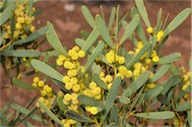In Flower This Week
A news sheet prepared by a Gardens' volunteer.
Numbers before each plant refer to temporary IFTW labels in the gardens.
Numbers in square brackets [ ] refer to garden bed Sections. Plants in flower are in bold type.
View past issues of 'In Flower This Week'.
2 September 2015
Acacia hakeoides click for larger image |
We will focus again on wattles in bloom. The car park provides a variety of species to enjoy.
- Turn left as you exit the Visitor Information Centre, then left down the hill to see on your right Acacia obliquinervia [Section 225]. This small open-crowned tree has pale grey-green phyllodes contrasting attractively with bright yellow balls of flowers. It is native to southern New South Wales and Victoria
- On your left is Acacia pycnantha [Section 224], or Golden Wattle, the floral emblem of Australia (pictured above). This small tree has green phyllodes with large yellow balls of flowers and is native to southeastern Australia.
- Further on your left is a clump of Acacia dawsonii [Section 224], or Poverty Wattle, medium-sized bushes with grey-green foliage covered in small yellow balls of flowers. This plant is native to New South Wales, Victoria and Queensland. Go down the steps.
- At the top of the steps on your right is the groundcover Acacia cultriformis ‘Cascade’ [Section 226], dropping over the wall in a fall of triangular green foliage and yellow balls of flowers.
- Bear right across the carpark to see on your left Acacia cardiophylla [Section 227], with divided feathery foliage and masses of small yellow flower balls. It is native to central and southern New South Wales.
- Also on your left is a prostrate form of Acacia baileyana [Section 227], or Cootamundra Wattle, with fringed grey-green foliage and yellow racemes of flowers.
- Further on your left is Acacia havilandiorum [Section 227], a small bush with grey-green needle foliage and gold ball flowers. It is native to New South Wales, Victoria and South Australia.
- Bear left with care down the road to see on your right Acacia buxifolia [Section 225], or Box-leaf Wattle, an open bush with red stems, small grey-green foliage and golden flowers. It is native to eastern Australia.
- Turn left into the carpark to see on your right Acacia williamsonii [Section 228], with yellow-green linear foliage and yellow balls of flowers. Whirrakee Wattle is native to southern New South Wales and Victoria.
- Further on your right is Acacia hakeoides [Section 228], or Hakea Wattle, a small tree with linear green foliage, reddish stems, and clusters of large yellow flower balls. It is native to southern Australia.
- Go down the steps, turn right along the footpath, and cross the car park to see in the far right-hand corner Acacia decurrens [Section 116], a tree with finely-divided green foliage and yellow balls of flowers. It has naturalised widely elsewhere in Australia, but is native to eastern New South Wales.
- Further on your right is Acacia subulata [Section 116], or Awl-leaf Wattle, a small tree with dark-green needle foliage and drooping clusters of pale yellow flower balls which open sequentially towards the tip. This wattle is endemic to New South Wales.
- Also on your right is Acacia buxifolia subsp. buxifolia [Section 116], a small bush with grey-green foliage and gold ball flowers.
- Bear left across the car park to the steps and take the pedestrian crossing into the grassland garden. On your right is Acacia genistifolia [Section 175], with spiky dark-green foliage and masses of cream ball flowers. It is native to eastern New South Wales, Victoria and Tasmania.
- Bear right along the boardwalk and left around the corner to see across the road Acacia filicifolia [Section 169], or Fern-leaf Wattle. This large tree has dark-green ferny foliage and pale yellow ball flowers. It occurs naturally in southern Queensland and New South Wales.
Rosalind Walcott
![Director of National Parks [logo]](../../../../images/dnp_90px.gif)







